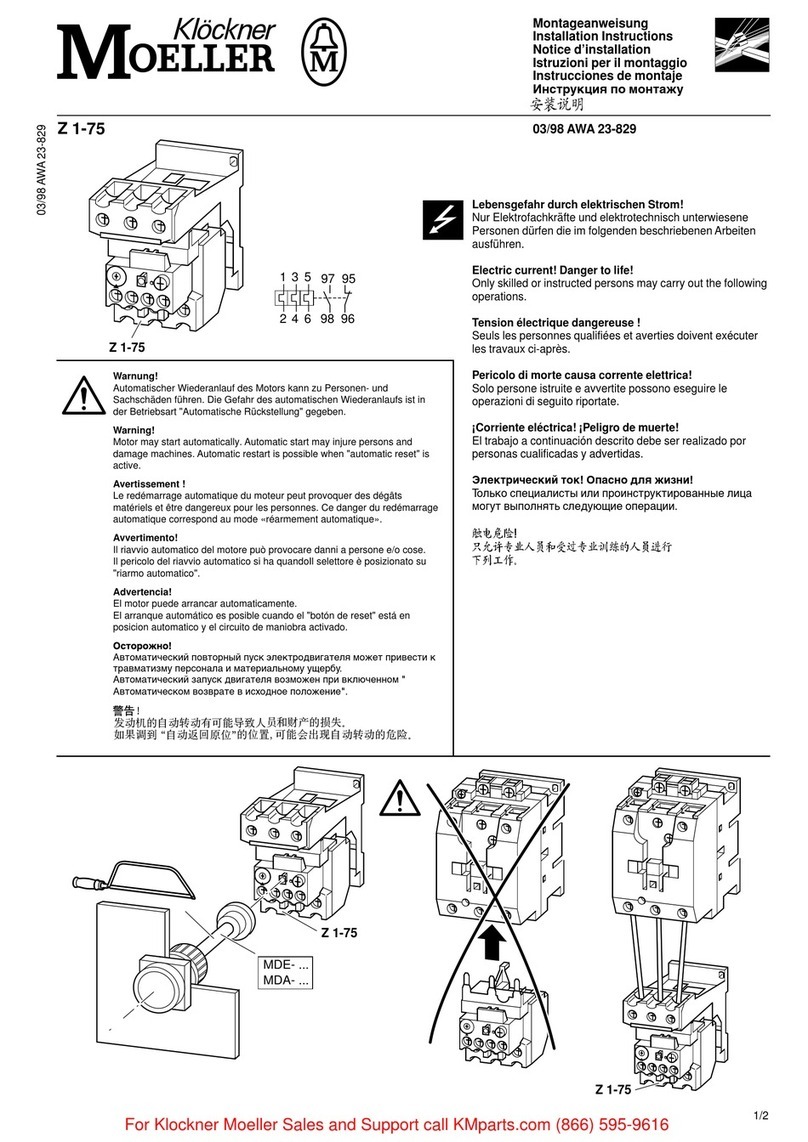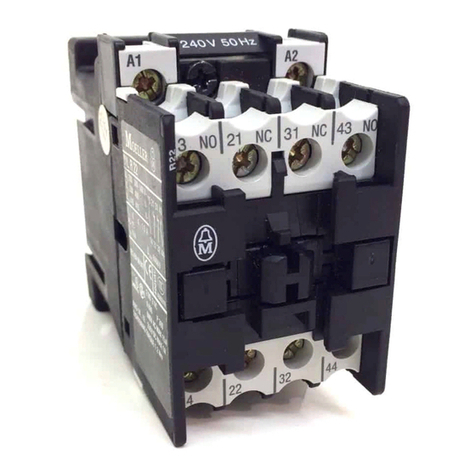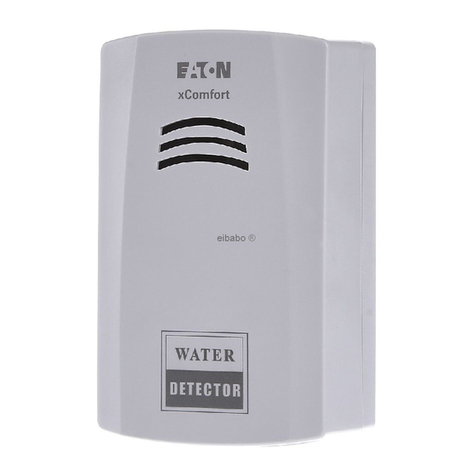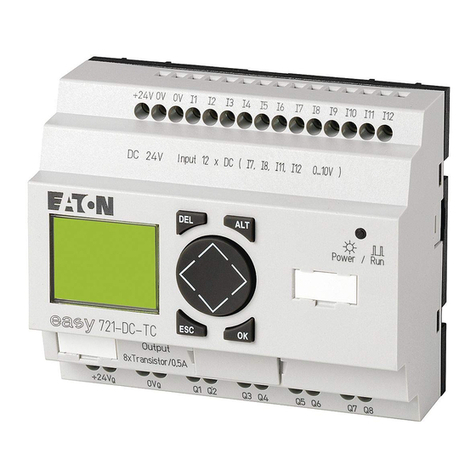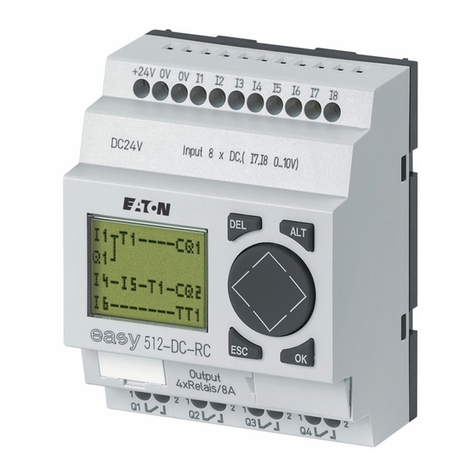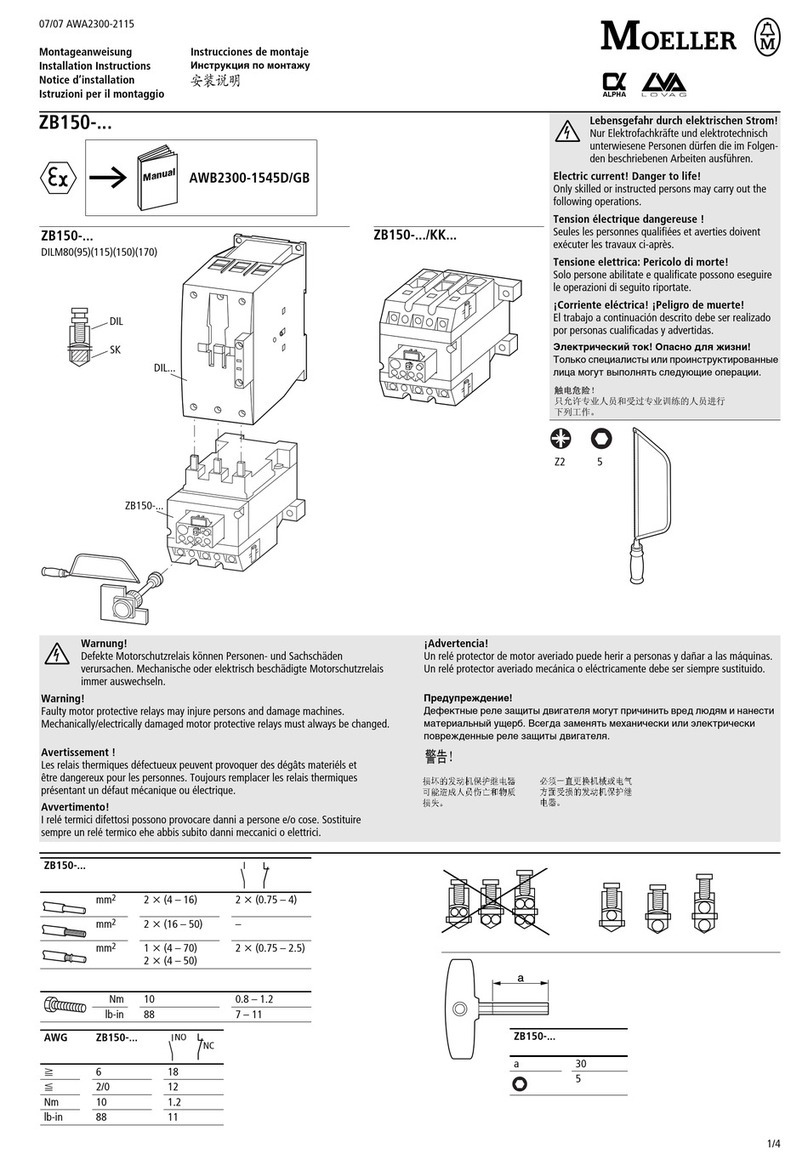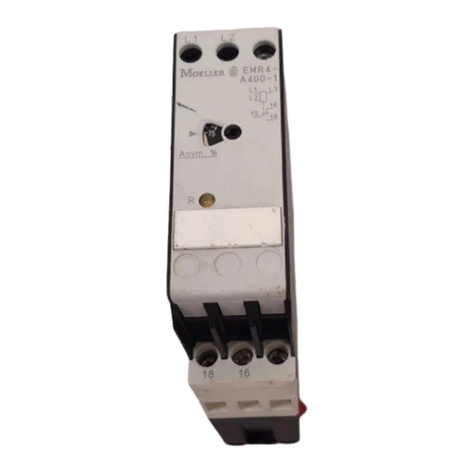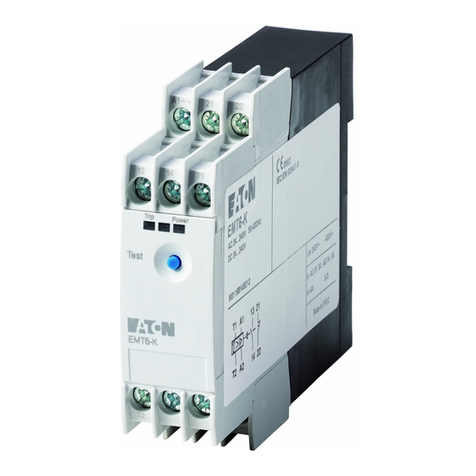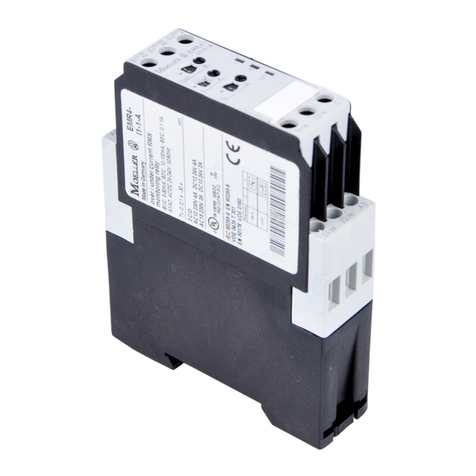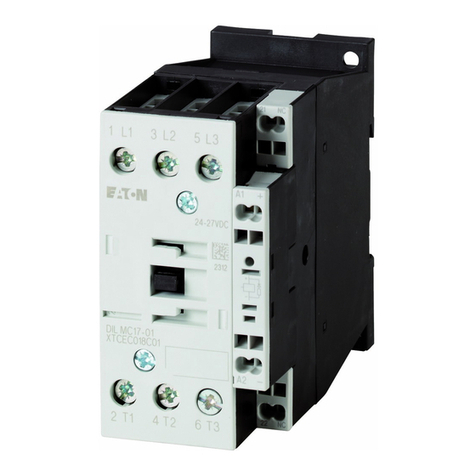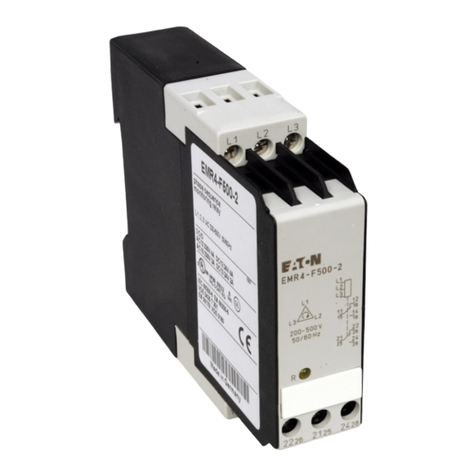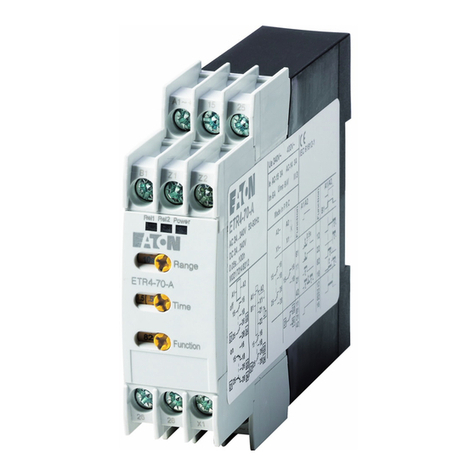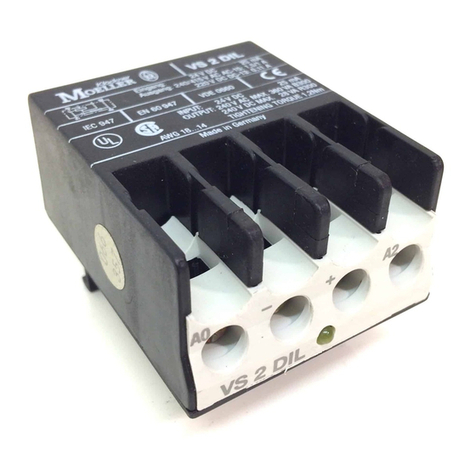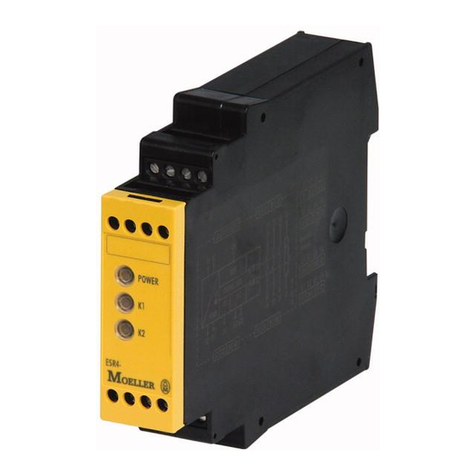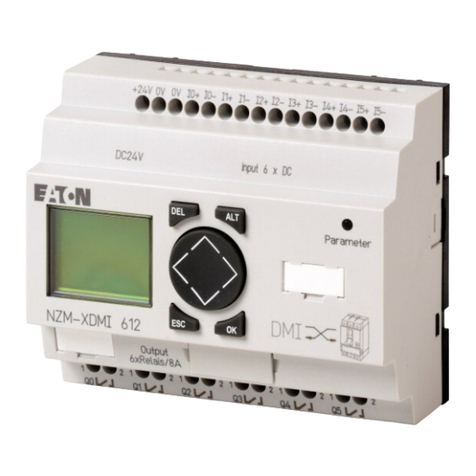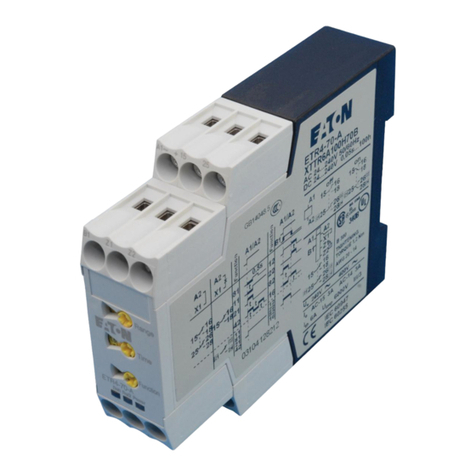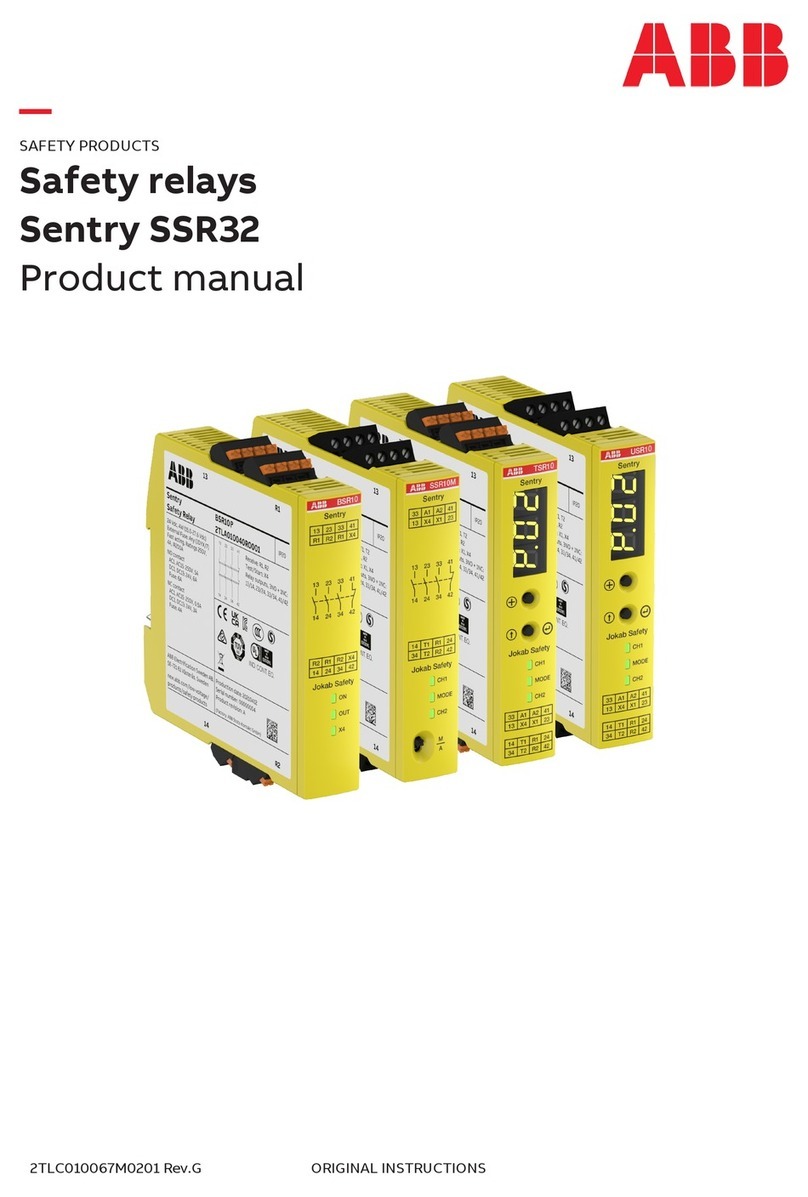
4
Operating Instruction
ESR4-NO-21, ESR4-NM-21
Basic device for Emergency-Stop and Safety Gate Applications
• Basic device to EN 60204-1 and EN 954-1 forsingle or dual E-stop monitoring.
• EN 954 category 4
• Stop category 0 acc. EN 60204-1
• Manual or automatic start
• Cross monitoring
• Feedback loop to monitoring external contactors
• 2 Enabling paths, 1 signalling path
• Rated voltage in the E-stop circuitDC 24 V
• Processing of signals from output switching devices (OSSD) of light curtains acc. DIN EN
61496-1.
• To connect to load side of safety mats acc. DIN EN 1760-1 (ESR4-NM-21)
• Debouncing of inputs (ESR4-NM-21)
Front View
Power LED green
K1 LED green
K2 LED green
Safety Instructions
Only trained professional electricians may
install, startup, modify, and retrofit this
equipment! Disconnect the device / system
from all power sources prior to starting any
work! If installation or system errors occur,
line voltage may be present at the control
circuit in devices without DC isolation!
Observe all electrical safety regulations
issued by the appropriate technical authorities
or the trade association. The safety function
can be lost if the device is not used for the
intended purpose. Opening the housing or
any other manipulation will void the warranty.
Caution!
Perform the following precautionary steps
prior to installation, assembly, or disassembly:
1. Disconnect supply voltage to the
equipment / system prior to starting any
work!
2. Lockout/tag the equipment / system to
prevent accidental activation!
3. Confirm that no voltage is present!
4. Ground the phases and short to ground!
5. Protect against adjacent live
components using guards and barriers!
6. The devices must be installed in a
cabinet with a protection class of at least
IP 54.
Caution!
Limited contact protection! Protection type
according to DIN EN 60529.
Housing/terminals: IP 40/ IP 20.
Finger-proof acc. to DIN VDE 0106 Part 1.
Description of Device and Function
ESR4-NO-21 This device is a two-channel safety switching device for emergency stop
applications with self-monitoring on each ON-OFF cycle. It conforms to EN 60204-1 and is
equipped with positively driven relays.
Basic function: After supply voltage hasbeen connected to terminals A1/A2 and the safety
inputs closed, operating the reset button closes the enabling current paths (manual start). When
the safety inputs are opened/de-excited the enabling current paths will open.
Operating modes / system functions
• One- or two-channel activation With single-channel activation both safety channels CH1
and CH2 are connected in parallel, with two-channel activation they are connected
separately.
• Without cross monitoring Both safety channels are connected to positive potential (S12
and S31 to S11).
• With cross monitoring Safety channel CH1 is connected to positive potential (S11 to S12)
and safety channel CH2 to negative potential (S21 to S22).
• Manual start When the safety inputs are closed,a button is used to openreset input S34
(triggering with falling edge) or to close reset input S35 (triggering with rising edge).
• Automatic start Reset input S35 is connected to S33. The device starts with the rising
edge of the signal on safety input S12.
• Starting lockout After supply voltage has been connected and the safety inputs closed, the
enabling paths will not close. Starting is only possible after the reset button has been
operated. For starting lockout the resetinputs have to be activated with the button, as in
manual start mode.
• Restarting lockout No restart after the safety inputs have been opened and closed.
Restarting is only possible after the reset button has been operated. For restarting lockout
the reset inputs have tobe activated with the button,as in manual start mode.
• OSSD-compatible OSSD signals from a light barrier or other safety sensors with
semiconductor outputs can be processed. Test pulses < tTP do not influence the device
functions. Test pulses > tTP can lock the device.
• Synchro-check With two-channel activation both safety channels are monitored together
with synchronous time tS. Safety channel CH1 must close before CH2 and bridge S33/S35
must be connected. If CH2 closes before CH1, the synchronous time tS=∞.
ESR4-NM-21 The functions correspond to thoseof ESR4-NO-21 without simultaneity monitoring.
The device is suitable for connecting to short-circuit-forming 4-wire switching mats, switching
strips and switching edges (without monitoring resistance). The device must be operated with two
channels and cross monitoring. If there is resistance < 50 Ω/channel and a short circuit between
the channels (S11/S12 and S21/S22) the enabling paths open and the SUPPLY LED flashes.
Input debouncing prevents fast consecutive switching of the enabling outputs when thesafety
inputs open for shorter thantASP. When the safety inputs open for longer than tASP the enabling
paths open after tR. Restarting is prevented for time tSP.
Please observe instructions from safety authorities.
9
Caract´ristiques techniques
Circuit d alimentation ESR4-NO-21 ESR4-NM-21
Tension nominale UNAC/DC 24 V
Puissance assign´e DC 2,0 W 2,1 W
Puissance assign´e AC 2,4 W / 4,4 VA 2,5 W / 4,6 VA
Ondulation r´siduelle 2,4 VSS
Fr´quence nominale 50 ... 60 Hz
Plage de la tension de service 0,85 ... 1,1 x UN
Fusible pour alimentation circuit de commande r´sistant aux courts-circuits (r´sistance
PTC) r´sistant aux courts-circuits (fusible
´lectronique)
Circuit de commande
Tension de sortie nominale S11, S33 contre S21 DC 22 V
Courant de sortie / courant de pointe 100 mA / 2000 mA 100 mA / 200 mA
Plage de la tension dêentr´e
High (haut) DC 17,4 V aDC26,4 V
Low (bas) DC ô3,0 V aDC +5,0 V
Courant nominal / courant de pointe S12, S31/S22 40 mA / 100 mA
Courant nominal / courant de pointe S34, S35 5 mA / 50 mA
Temps dêimpulsion de test admis tTP / fr´quence de test ≤1000 µs / ≤10 s-1
Temps de fonctionnement tA1 S34 20 ms a40 ms
Temps de fonctionnement tA2 S35 200 ms a500 ms 20 ms a80 ms
Dur´e mini de maintien tMS34, S35 > 50 ms
Temps de blocage tSP --- 70 ms a130 ms
Temps de fonctionnement du blocage tASP --- > 7 ms
Temps de r´armement tW≥40 ms ≥150 ms
Temps de relÜchement tRK1, K2 < 25 ms
Temps de controle du d´synchronisme ≈200 ms --
Circuit de sortie
Contacts de sortie
Equipement des contacts 2 contacts de travail, aguidage forc´
Tension nominale de coupure UnAC 240 V / DC 300 V
Courant continu max. Inpour chaque contact 6 A
Courant total max. de tous les contacts 12 A
AC-15 : Ue 230 V, Ie 4 A (360 h-1) DC-13: Ue 24 V, Ie 4 A (360 h-1)Cat´gorie dêutilisation selon IEC 947 - 5 - 1 AC-15 : Ue 230 V, Ie 3 A (3600 h-1) DC-13: Ue 24 V, Ie 2,5 A (3600 h-1)
Dur´e de vie m´canique 10 x 106commutations
Contacts de signalisation
Equipement des contacts 1 contact de rupture, parallele, aguidage forc´
Tension nominale de coupure UnAC 240 V / DC 300 V
Courant continu max. Inpour chaque contact 6 A
AC-15 : Ue 230 V, Ie 4 A (360 h-1) DC-13: Ue 24 V, Ie 4 A (360 h-1)Cat´gorie dêutilisation selon IEC 947 - 5 - 1 AC-15 : Ue 230 V, Ie 3 A (3600 h-1) DC-13: Ue 24 V, Ie 2,5 A (3600 h-1)
Dur´e de vie m´canique 10 x 106commutations
Caract´ristiques g´n´rales
Cheminements et claquage entre les circuits ´lectriques selon DIN VDE 0110 partie 1 : 04.97
Surtension transitoire assign´e 4 kV
Degr´de pollution de lêappareil : alêint´rieur / alêext´rieur 2 / 3
Tension assign´e AC 300 V
Classe de protection selon DIN VDE 0470 partie 1 : Boıtier /
bornes IP 40 / IP 20
Temp´rature ambiante / de stockage -25 ... +55 / -25 ... +75 C
Poids 0,21 kg
Donn´es sur les bornes et les connexions
Unifilaire (fil rigide) ou fils de faible diametre (multibrins) 1 x 0,14 mmè a 2,5 mmè2 x 0,14 mmè a 0,75 mmè
Longueur de d´nudation max. 8 mm
Fil afaible diametre (multibrins)avec embout selon DIN
46228 1 x 0,25 mmè a 2,5 mmè2 x 0,25 mmè a 0,5 mmè
Couple de serrage max. 0,5 a0,6 Nm

